
Heat Stress In Plants: Shielding Crops From A Hot Spell
When plants are subjected to high temperatures for a long time, they might experience stress. If farmers don’t take precautions against high temperatures, heat stress has negative effects on plants and reduces harvests. Heat stress in plants, however, is not always obvious because its symptoms are similar to those of other diseases. To find out if crops are suffering from stress and protect them in a timely manner, it is important to use accurate weather data and other clues, such as those given by advanced precision agriculture platforms.
What Is Heat Stress In Plants, And What Does Cause It?
To put it simply, heat stress is what happens to plants when they are exposed to enormous amounts of sunlight and heat for too long. The term “heat stress” often refers to a period in which plants are subjected to high temperatures for long enough to permanently alter their ability to function or grow normally.
The ideal range for most crops is between 68 and 86 degrees Fahrenheit (20 and 30°C). Temperatures outside this range, whether in the air or the soil, during the day or the night, are harmful to plants. Heat stress is the cumulative effect of the heat’s severity, the time the plant is exposed to the heat, and the rate at which the temperature is rising.

What Are The Signs Of Heat Stress In Plants?
Heat stress in plants manifests itself in many ways. Yet it may be hard to pin down because its symptoms resemble those caused by certain crop diseases or pests. Moreover, heat and drought stress can lead to plant diseases as well. When considered together, the following symptoms of heat stress will allow for a more precise diagnosis.
- Rolling and cupping of leaves. This is the mechanism by which plants (such as corn and tomatoes) regulate their water loss. The leaf’s surface area shrinks, and its stomata (tiny pores that enable gas and moisture exchange) close.
- Wilting. The wilting point occurs when there is less moisture available than a plant can absorb, leading to a deficit of water pressure inside the plant. Each further delay in treating a plant wilted from heat stress raises the risk that it may suffer irreversible damage. There is a high likelihood that plants are experiencing heat stress if they wilt during the day’s hottest period and then revive in the evening or morning.
- Dried Leaf Margins. Some types of crops dry off the leaf’s outer edges to ensure survival. Because there is “extra” room in the leaves of crops like pumpkins and squash, they can persist with their normal function even when heat stress burns the margins of plant leaves.
- Damage By Ozone. When high temperatures are paired with low air quality, plants can be damaged by ozone. As the gas enters leaves through stomata, it burns plant tissue. Dry brown dots between leaf veins are indicative of ozone damage in tomatoes. Leaves of squash, cucumbers, and pumpkins exposed to ozone damage turn a pale yellow and look extremely dried out.
- Flower And/Or Fruit Drop. Because of heat stress, many ornamental plants either fail to bloom or lose their buds and blossoms. During a heat wave, the plant can prioritize keeping its vital organs over other, less critical needs. Hot weather causes flower and fruit drops in cucumbers, squash, and peppers.
- Bolting. This process, called “bolting,” may be fatal when growing lettuce and other cool-weather crops. Bolting is common while growing broccoli, spinach, cauliflower, and cilantro in hot soil.
- Sunscald. Several fruits, including apples, tomatoes, and melons, scorch in extreme heat, usually on the side that directly faces the sun. Sunscald can show up on different kinds of fruit as discoloration, watery spots, blisters, or firm, sunken patches on the surface, as well as parched fruit.
- Blossom-End Rot. When heat and high solar radiation affect the leaves of plants, as is common when growing tomatoes, photosynthesis and transpiration speed up. By diverting water and calcium from the fruits to the leaves, this causes blossom-end rot (BER), which appears as a dark, watery stain on the fruit.
Fields monitoring platform, leveraging high-resolution satellite images to identify and react to any changes remotely!EOSDA Crop Monitoring
What Are The Effects Of Heat Stress On Plants?
Heat stress triggers dehydration in plants, which stunts their development. Reduced photosynthetic production is a direct result of heat stress’s effect on the leaf relative water content (RWC) and the plant’s water potential. Thus, heat stress leads plants to lose water and wilt. In the case of temporary or moderate heat stress, however, plants are able to control their respiration and transpiration rates to achieve a thermal balance.
Because of heat stress, the concentration of soluble proteins and sugars is adjusted to control the osmotic pressure inside the plant cell. Last but not least, you may observe losses in crop production because of heat stress across the board, impacting every crop from cereals and legumes to root vegetables.
Some of the most critical alterations to biochemistry and physiology that plants undergo because of heat stress are:
- closing stomata in response to high temperatures prevents plants from taking in enough carbon dioxide (CO2) for photosynthesis, which can stunt their growth and diminish their yield;
- damage to proteins at high temperatures reduces enzyme function, which in turn affects many metabolic processes;
- extreme heat can provoke oxidative stress, which harms plant cells and impairs their growth by releasing reactive oxygen species (ROS);
- excessive daytime temperatures and solar radiation during the fruit development stage reduce sugar and starch content in growing watermelons and other sweet fruits;
- increased transpiration rates due to high temperatures lower the amount of water available to crops, resulting in water stress.
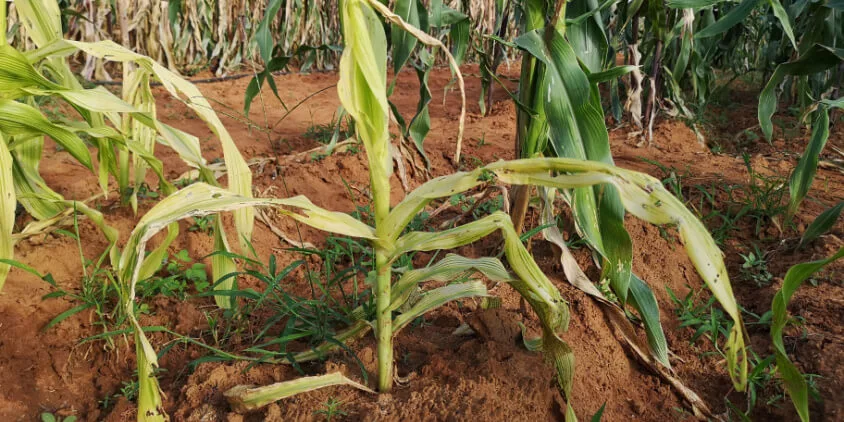
How To Save Plants From Heat Stress
Although growers can’t do much about the weather, they can nonetheless protect their crops from heat stress and reduce losses by careful crop damage assessment and employing certain farm management practices. Some of these methods are geared toward protecting plants from experiencing heat stress, while others aim to help them adjust to the heat.
Practices For Preventing Heat Stress In Plants
Most of the time, when plants experience trouble due to relatively short heat waves, the problems go away quickly after the heat subsides. If you take the following measures to reduce heat stress on plants during a heat wave, they should recover once the temperature drops.
Temporary Shading
To shield your crops from excessive sunshine during heat waves, use temporary shading. It is essential to shade crops during the midday sun to prevent stress. Meanwhile, when the days get shorter and the weather cools down, you should keep your crops from being overly shaded.
Sufficient Watering
Irrigation practices that keep soil moist can help in the alleviation of heat stress on plants. To ensure that all of your crops in the field receive adequate moisture, precision irrigation should take place either early in the morning or in the evening. During the heat of the day, water sprayed from above will evaporate before it can reach the plants’ roots. Avoid water loss due to evaporation by employing a drip or soaker hose water supply.
No Fertilizing
It’s not a good idea to fertilize during a heat wave. Fertilization applied without sufficient water could damage plant tissues since the crop responds to a rapid influx of nutrients by beginning to grow. The young, developing parts are especially vulnerable to the negative effects of high temperatures, and the plant is put under additional stress and at increased risk when temperatures soar.
Applying Mulch
Soil temperatures rise with the sun’s intensity, adding another factor to heat stress for plants. Covering the soil with a mulch — a layer of straw, hay, leaves, pine needles, and grass clippings — that is 4 to 6 inches (10 to 15 cm) thick can help reduce the temperature and lessen the adverse impacts of heat on plant roots.
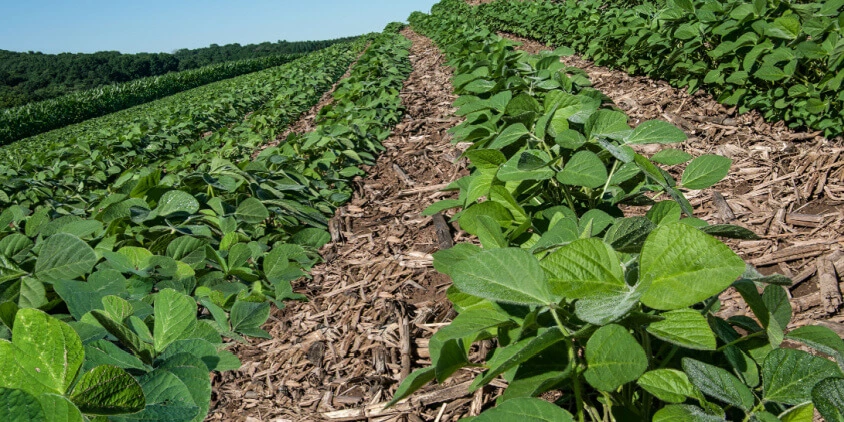
Little To No Chemical Treatment
Prolonged temperatures over 80°F (27°C) render many remedies for crop diseases and pests ineffective or even harmful. Treatments, even mild ones like soap and oils, given to conifer trees and succulents during periods of severe heat might cause further harm.
Eradication Of Weeds
A heat wave is no excuse to put off weeding the field. Most weeds are more able to withstand heat stress than cultivated plants, making them competitors for moisture and nutrients. That’s why it’s important to get rid of as many weeds as you can so your crops can survive in the heat.
Genetic Enhancement Of Heat Tolerance
There is a pressing need to breed heat-resistant crop cultivars, particularly wheat, in light of the impending effects of climate change. Conventional, molecular, and transgenic breeding techniques can all be used to increase plant heat tolerance . To mitigate the long-term impacts of heat stress on plants, farmers can benefit from producing heat-tolerant varieties.
Cultural Farming Practices
Managing heat stress requires protecting crops from extreme temperatures at key stages of plant growth, which can be done through timely planting, optimal crop spacing, thinning, pruning, and other appropriate cultural practices.
Facilitating Heat Stress Adaptation In Plants
Plants can store information about past heat stress (thermo-priming) and use it to prepare for future heat events, protecting them from as much damage as possible (thermotolerance). They can change the shape of their leaves and other parts to tolerate high temperatures easier. To adapt to high temperatures, some plants will modify their leaves’ orientation, roll their leaves, or develop tiny hairs that cast a shadow across the leaf’s surface.
Normal plant acclimations to heat and drought stress include the leaves getting smaller, changing shape, or changing color. Because they have less surface area in the direct sun, smaller leaves can retain more water and stay cooler than their larger counterparts. Gray leaves reflect less light than their dark-green counterparts.
When crops are under severe heat stress, they often lose their leaves. Lower leaf counts reduce water loss through stomates, stems, and other plant parts. Some buds, blossoms, and growing fruit may fall off. The plant response to heat stress may also involve decreasing its metabolic rate. In some cases, this may necessitate alterations to the amount of water, salt, proteins, and phytohormones present in the cells.
Plants adjust to heat stress by changing their morphology, physiology, and biochemistry, so studying their response using phenological analysis can pave the way for more precise molecular characterization of the tolerance traits . Understanding the required agronomic features is crucial for the eventual implementation of heat-tolerant crops under various climatic conditions, especially in light of global warming.
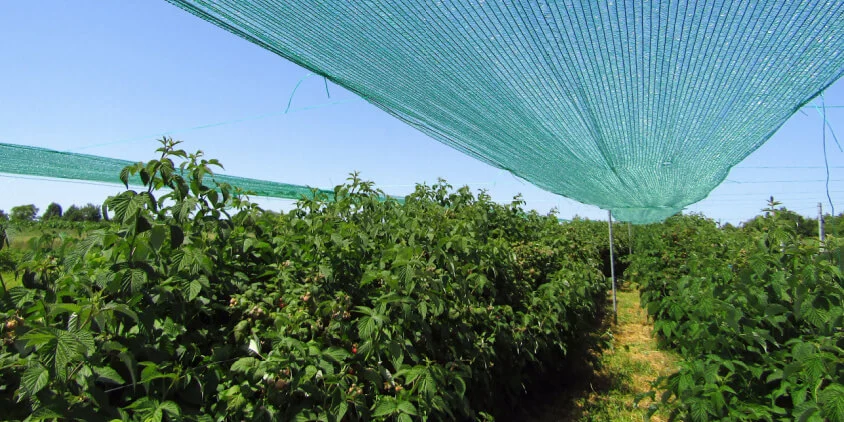
Can A Plant Recover From Heat Stress?
Crops can overcome heat stress, but only if the condition is temporary. The above measures can help your plants temporarily adapt to high temperatures. But if you leave them in this stress for too long, they probably won’t survive.
How Long Does It Take For A Plant To Recover From Heat Stress?
For heat-stressed plants, the road to recovery could take anywhere from a few days to a few months. The time needed to recover from stress is proportional to the severity of the damage. Plant heat stress recovery may take months for crops that have been ignored for too long during a heatwave; in extreme cases, it may be impossible to bring them back to life.
How To Help Plants Recover From Heat Stress
Healthy plants are resilient to stress, and they can bounce back as long as they are provided with adequate care, water, and shade. If your plants are under heat stress, you can take the following measures to reduce damage and speed recovery:
- set up a temporary sunshade, like a shade cloth in lighter colors;
- in the morning or evening, use drip irrigation to thoroughly water your crops;
- spread mulch in a 2- to 3-inch-deep (5-8 cm) ground layer to help moderate soil temperature and retain moisture;
- do not attempt replanting;
- wait until the heat wave is over before applying fertilizer;
- remove dead flowers, but be careful not to prune away any healthy tissue or leaves that are only partially dead. The leaves will cast a shadow over the stressed plants in any case, protecting the remaining green areas from direct sunlight and allowing them to continue photosynthesis.
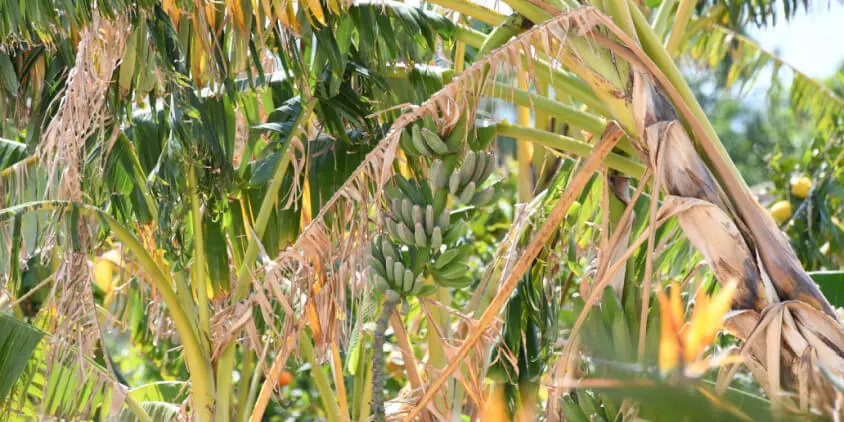
Cold Stress In Plants — The Effects Of Inverse Temperature Extremes
Cold stress, as opposed to heat stress, happens when the air and soil temperatures fall below the ideal range for plant development. This can have a detrimental effect on crop growth. During cold stress, plants undergo a variety of biochemical and physiological abnormalities, which can result in such plant cold stress symptoms as stunted growth, decreased yield, and, in extreme circumstances, death. Cold-regulated (COR) genes and the buildup of cryoprotectants, including sugars, proteins, and amino acids, which minimize drying and preserve cell membranes, have evolved as cold stress tolerance mechanisms in plants.
The ability of a plant to tolerate cold temperatures depends on the species as well as the rate and intensity of temperature drops. When temperatures decline gradually, a plant can acclimatize, or adapt, to cooler temperatures more effectively. Rapid temperature drops inflict more crop stress and damage in the fall and early winter than they do later in the season .
Farmers can protect plants from low temperatures through appropriate selection and maintenance. Adequate irrigation before a frost can promote crop protection during a cold spell. Well-watered soil stores more warmth and then reradiates it, increasing plant resistance to cold stress. Mulch also aids in soil moisture retention during the cold season. Agriculture producers require timely access to meteorological data, heat and frost damage assessment, and a firm grasp on the dynamics of crop growth and microclimate changes in their fields so they can take prompt measures to protect plants from abiotic stress factors.
How EOSDA Crop Monitoring Assists In Detecting And Addressing Cold And Heat Stress
All participants in the agro-industry need to keep an eye on the weather in agriculture as well as soil conditions, most importantly soil moisture, to spot the signs of cold and heat stress in plants early on. Agriculturists can safeguard their crops from the effects of extreme temperatures by first determining which areas are at greatest risk and then taking appropriate preventative and corrective measures there.
Weather Tracking In EOSDA Crop Monitoring
With EOSDA Crop Monitoring, you can access three distinct types of weather information at any time: historical records, current readings, and forecasts. As you add fields to your account, statistics like these will be collected for each of them. These datasets are broader and more accurate than open-source weather data since they use a variety of resources, such as satellite imagery, ground-based meteorological stations, and comprehensive weather prediction models and algorithms.
To protect your crops from the negative effects of extreme temperatures, you can do the following:
- keep an eye on the current temperatures and other meteorological parameters, including precipitation, wind, humidity, and clouds, as they are updated daily;
- research past weather records (information is accessible from 1979 onwards) to identify potentially dangerous periods;
- consult a reliable 14-day forecast and plan ahead to protect your plants from cold and heat stress.
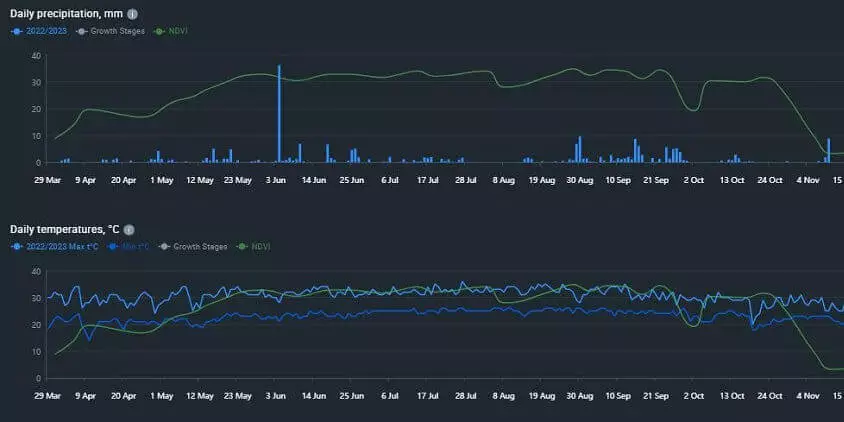
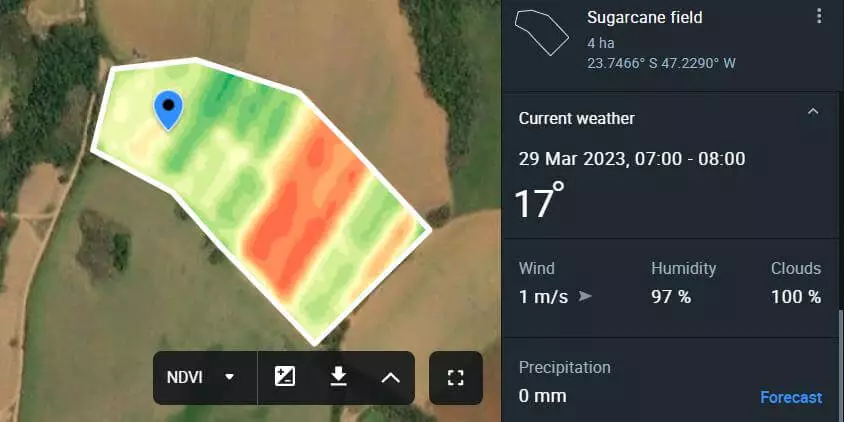

Heat/Cold Stress Alerts
On the EOSDA Crop Monitoring platform, not only can you get daily field temperature readings, but you can also activate heat and cold stress detection. The Weather risk notifications add-on warns you of impending severe weather in your area. When the average daily temperature drops below a certain threshold, it indicates that the culture is experiencing cold stress, and when it rises over that threshold, it indicates that there’s heat stress in plants.
Using the Weather risk notifications add-on, you may adjust the threshold value and establish a specific temperature to flag fields that are under stress. These timely automatic alerts will ensure that you don’t miss the impending danger and can instead take the necessary precautions in the field to protect your crop from extreme temperatures.
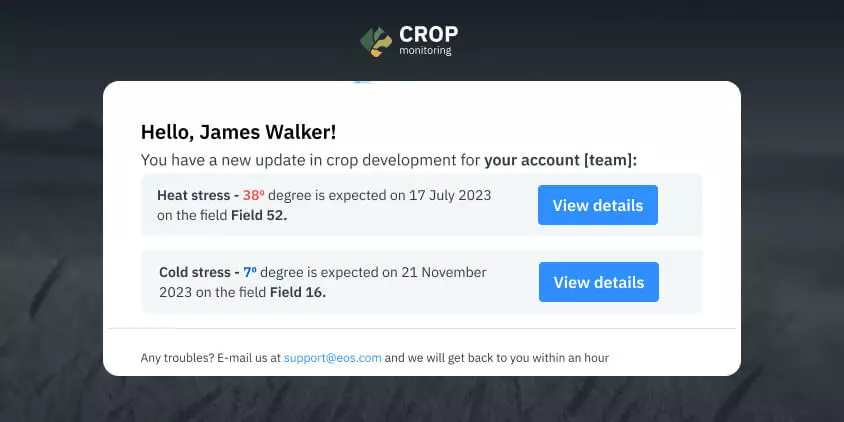
Along with changes in temperature, EOSDA Crop Monitoring may also let you know when the NDVI vegetation index in the field changes. In this way, adverse changes in the field can be identified early on, leading to a more thorough inquiry into their causes (such as a lack of water, pests, diseases, etc.) and the subsequent execution of corrective activities to promote crop growth. By observing how the density of the field’s vegetation responds to a change in the weather, you can also draw conclusions about the connection between the two.

Detection Of Heat/Cold Stress Based On Historical Weather Records
As a bonus, EOSDA Crop Monitoring allows you to look back at historical data to determine when in the growing season you need to be especially vigilant about protecting your crops from the effects of hot or cold weather. Users of EOSDA Crop Monitoring who have upgraded to the Pro subscription get access to a historical database of data on cold and heat stress in plants. This information will be useful for planning next season’s watering and other measures to protect plants from a heat wave.

Managing Field Activities In EOSDA Crop Monitoring
Farmers can decide when to plant next season by looking at how the temperature has changed in their field over the past few years. You may think of the Field Activity Log as a calendar for managing work on every field you’ve ever added to your account. Any field operation, from planting to tillage to watering, may be given a date, an executor, task notes, and comments from the executor. All of this makes it easier for large agritech companies to oversee and have full control over all of their operations in every region and under any climate condition.
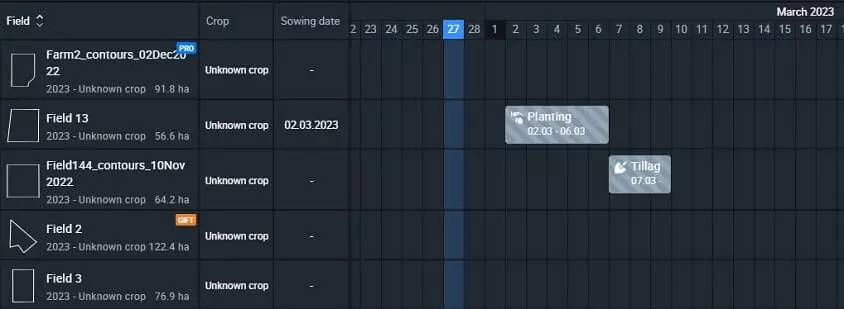
Every participant in the agriculture industry will benefit from EOSDA Crop Monitoring:
- using historical data, agricultural consultants can adjust crop planting timings;
- insurance firms and banks can factor in cold and heat stress in plants when calculating crop loss payouts;
- non-governmental organizations (NGOs) can develop the best strategies for field management, especially in underdeveloped rural areas.
Why Should Agritech Majors Keep An Eye On Cold And Heat Stress In Plants?
From planting through harvest, every step of the plant’s life cycle has the potential for danger. Heat and cold stress both harm plants, delaying crop development or even killing them. As a result, it is crucial for large agricultural companies to anticipate the potential for cold or heat stress in plants and take measures to mitigate it. Meanwhile, timely insights allow them to minimize the impact of adverse weather on crops and still harvest abundant crops.
About the author:
Vasyl Cherlinka is a Doctor of Biosciences specializing in pedology (soil science), with 30 years of experience in the field. He attended the engineering college in Ukraine and received his degree in agrochemistry, agronomy and soil science in the Chernivtsi National University. Since 2018, Dr. Cherlinka has been advising EOSDA on problems in soil science, agronomy, and agrochemistry.
Recent articles
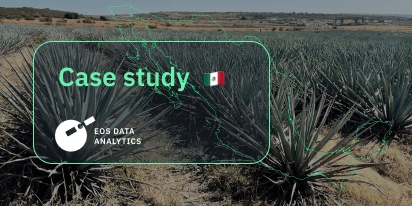
Digital Tools Improve Soil Health And Yields In Mexico
EOSDA and ITTA supported a Guanajuato farm with contour-line planning, monitoring tools, and practical guidance to reduce soil erosion and improve yields in the long run.

Analyze 2025 & Plan Your Best Year Yet: LandViewer Christmas Offer
It’s the most wonderful time of the year! The Christmas holidays are here, and so is your chance to analyze 2025 and plan a prosperous 2026 with more affordable Pro plans in LandViewer.

EOSDA Models Climate Change Impact On Sugarcane Yields
EOSDA modeled future temperature, rainfall, and other climate impacts on Veracruz sugarcane. The results help growers plan long-term adaptation strategies, including timing, varieties, and irrigation.